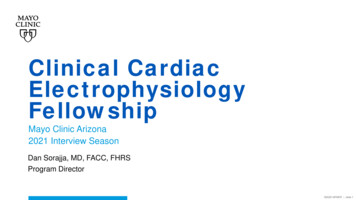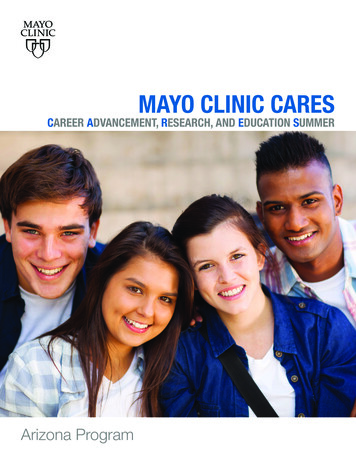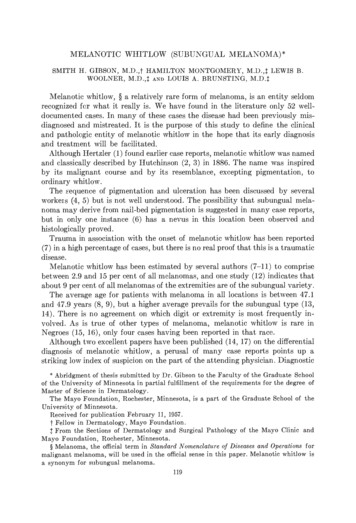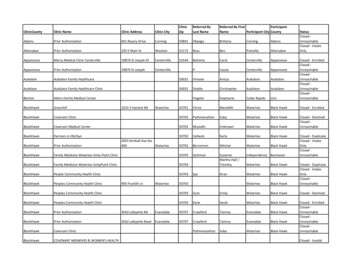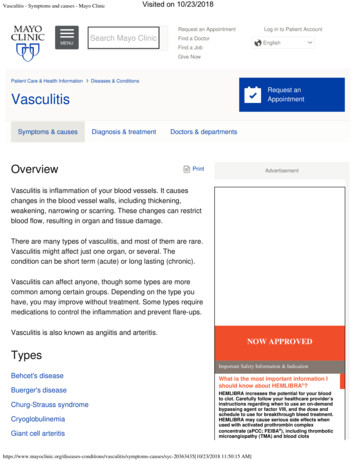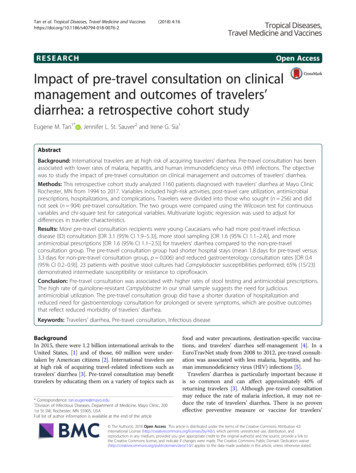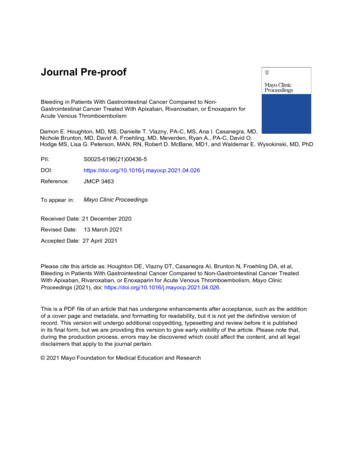
Transcription
Journal Pre-proofBleeding in Patients With Gastrointestinal Cancer Compared to NonGastrointestinal Cancer Treated With Apixaban, Rivaroxaban, or Enoxaparin forAcute Venous ThromboembolismDamon E. Houghton, MD, MS, Danielle T. Vlazny, PA-C, MS, Ana I. Casanegra, MD,Nichole Brunton, MD, David A. Froehling, MD, Meverden, Ryan A., PA-C, David O.Hodge MS, Lisa G. Peterson, MAN, RN, Robert D. McBane, MD1, and Waldemar E. Wysokinski, MD, .1016/j.mayocp.2021.04.026Reference :JMCP 3463To appear in:Mayo Clinic ProceedingsReceived Date: 21 December 2020Revised Date:13 March 2021Accepted Date: 27 April 2021Please cite this article as: Houghton DE, Vlazny DT, Casanegra AI, Brunton N, Froehling DA, et al,Bleeding in Patients With Gastrointestinal Cancer Compared to Non-Gastrointestinal Cancer TreatedWith Apixaban, Rivaroxaban, or Enoxaparin for Acute Venous Thromboembolism, Mayo ClinicProceedings (2021), doi: https://doi.org/10.1016/j.mayocp.2021.04.026.This is a PDF file of an article that has undergone enhancements after acceptance, such as the additionof a cover page and metadata, and formatting for readability, but it is not yet the definitive version ofrecord. This version will undergo additional copyediting, typesetting and review before it is publishedin its final form, but we are providing this version to give early visibility of the article. Please note that,during the production process, errors may be discovered which could affect the content, and all legaldisclaimers that apply to the journal pertain. 2021 Mayo Foundation for Medical Education and Research
Mayo Clinic ProceedingsSafety of DOACs in GI CancerBleeding in Patients With Gastrointestinal Cancer Compared to Non-GastrointestinalCancer Treated With Apixaban, Rivaroxaban, or Enoxaparin for Acute VenousThromboembolismDamon E. Houghton, MD, MS1, Danielle T. Vlazny, PA-C, MS1, Ana I. Casanegra, MD1,Nichole Brunton, MD2, David A. Froehling, MD1, Meverden, Ryan A., PA-C1, David O.Hodge MS3, Lisa G. Peterson, MAN, RN1, Robert D. McBane, MD1, and Waldemar E.Wysokinski, MD, PhD1.1Gonda Vascular Center, Thrombophilia Clinic, Department of Cardiovascular Diseases,Mayo Clinic Rochester, MN, 2Danbury Hospital, Danbury, CT, 3Department of HealthSciences Research, Mayo Clinic, Jacksonville, FLFinancial support and conflict of interest disclosure:This work was partially supported by the discretionary fund from Gonda VascularCenter, Mayo Clinic Rochester.Robert D. McBane has Research Grant from Bristol Myers Squibb. All remainingauthors have declared no conflicts of interest.Correspondence: Address to Waldemar E. Wysokinski, MD, PhD, Department ofCardiovascular Diseases and Internal Medicine, Mayo Clinic, 200 First St SW,Rochester, MN 55905 (wysokinski.waldemar@mayo.edu). 2021 Mayo Foundation for Medical Education and Research. Mayo Clin Proc. 2021;96(x):xx-xx.
Mayo Clinic ProceedingsSafety of DOACs in GI CancerABSTRACT:Objective: To compare the bleeding risk in patients with gastrointestinal (GI) cancer tonon-GI cancer treated with anticoagulation for acute cancer-associated VTE (Ca-VTE).Patients and Methods: Consecutive patients with Ca-VTE seen at the MayoThrombophilia Clinic between March 1, 2013, through April 20, 2020, were followedprospectively to assess major bleeding, and clinically relevant non-major bleeding(CRNMB).Results: In the group of 1392 Ca-VTE patients, 499 (35.84%) had GI cancer including272 with luminal GI cancer (lower GI: 208 and upper GI: 64), 176 pancreatic, and 51with hepatobiliary. The rate of major bleeding and CRNMB was similar in GI cancercompared to non-GI cancer patients (n 893) treated with apixaban, rivaroxaban, orenoxaparin. Apixaban had a higher rate of major bleeding in luminal GI cancercompared to the non-GI cancer group (15.59 vs 3.73 per 100 person-years, p .004) andcompared to enoxaparin in luminal GI cancer patients (15.59 vs 3.17, p .04). Apixabanhad a lower rate of CRNMB compared to rivaroxaban in GI cancer patients (3.83 vs9.40 per 100 person-years, p .03). Patients treated with rivaroxaban had a similar majorbleeding rate in the luminal GI cancer compared to non-GI cancer patients (2.04 vs 4.91per 100 person-years, p .37).Conclusions: Apixaban has a higher rate of major bleeding in luminal GI cancercompared to non-GI cancer patients and compared to enoxaparin in luminal GI cancerpatients. Rivaroxaban shows no increased risk of major bleeding in GI cancer or luminalGI cancer compared to non-GI cancer patients.ClinicalTrials.gov: NCT03504007 2021 Mayo Foundation for Medical Education and Research. Mayo Clin Proc. 2021;96(x):xx-xx.
Mayo Clinic ProceedingsSafety of DOACs in GI CancerAlphabetic list of abbreviations:Ca-VTE - cancer-associated venous thromboembolismCRNMB - clinically relevant non-major bleedingDOACs - direct oral anticoagulantsGI - gastrointestinalLMWH - low molecular weight heparinPE - pulmonary embolismVTE - venous thromboembolism 2021 Mayo Foundation for Medical Education and Research. Mayo Clin Proc. 2021;96(x):xx-xx.
Mayo Clinic ProceedingsSafety of DOACs in GI CancerINTRODUCTIONDirect oral anticoagulants (DOACs) are equally effective and safer than warfarinin the treatment and secondary prevention of venous thromboembolism (VTE) (1-6) butsince patients with cancer-associated VTE (Ca-VTE) are at increased risk for bothrecurrent VTE and bleeding new studies specifically designated for Ca-VTE werenecessary. In recent trials, edoxaban was found to be non-inferior and rivaroxabansuperior to dalteparin in the prevention of VTE recurrence (7,8). However, increasedmajor bleeding with edoxaban and clinically relevant non-major bleeding (CRNMB) withrivaroxaban was observed. There have been specific concerns about the increased riskof bleeding among patients with gastrointestinal (GI) malignancies. These results led toguideline changes recommending edoxaban and rivaroxaban as alternatives to lowmolecular weight (LMWH) in Ca-VTE patients, but not in GI cancers (9,10). However,these updated guidelines concerning patients with GI cancer were established based ona relatively small number of patients. Moreover, it remains unclear if this restrictionapplies to the whole group of GI malignancies or only to luminal GI cancers.Recently published ADAM-VTE and Caravaggio trials revealed similar majorbleeding and CRNMB rates of apixaban compared to dalteparin (11,12) but no separateanalysis of safety for patients with GI cancer was performed.Using prospectively collected data from a unique setting of standardized,guideline-directed clinical practice of a single institution, we compared bleeding rates inall patients with GI cancer, and the subgroup of patients with luminal GI cancer to thepatients with non-gastrointestinal (non-GI) cancer treated with apixaban, rivaroxaban, orLMWH. 2021 Mayo Foundation for Medical Education and Research. Mayo Clin Proc. 2021;96(x):xx-xx.
Mayo Clinic ProceedingsSafety of DOACs in GI CancerPATIENTS AND METHODS.Patient recruitment.Consecutive patients with acute Ca-VTE treated at the Thrombophilia Clinic,Gonda Vascular Center, Mayo Clinic Rochester between March 1, 2013, and April 20,2020, were included in this study. The Thrombophilia Clinic’s highly organized system ofprompt patient referral, guideline-supported patient care, and organized follow-up havebeen previously described (13,14). Templated, information about available FDAapproved anticoagulants for Ca-VTE is provided utilizing a standardized script forproviders and a summary table with medication characteristics for the patient (seeonline supplementary material, page 16-23). After presenting this standardizedinformation the patient decides which anticoagulant to choose based on the patient’santicipation of having difficulty eating while taking rivaroxaban or taking medication suchas apixaban twice a day. Except for preferential use of apixaban in patients with renalfailure, no other suggestions regarding anticoagulant choice are provided by theattending physician. The prescription for anticoagulation is promptly filled at thepharmacy located within the same building. When the patient prefers to use a localpharmacy or begin oral anticoagulation the next day, an initial weight-based dose ofLMWH is injected at the Thrombophilia Clinic. Hospitalized patients are evaluated byVascular Medicine in-patient service and have a follow-up visit at the ThrombophiliaClinic arranged after discharge.Peri-procedural management of anticoagulation was standardized and describedin detail in our previous publications (13,14). Also, changing the dose of DOACs and 2021 Mayo Foundation for Medical Education and Research. Mayo Clin Proc. 2021;96(x):xx-xx.
Mayo Clinic ProceedingsSafety of DOACs in GI CancerLMWH with thrombocytopenia and renal failure were previously described (13,14). Thisstudy was approved by the Mayo Clinic Institutional Review Board in Rochester, MN.Surveillance and follow-up.To be concordant with the current guidelines (9,10, 15), extended treatment for aminimum of 6 months or until active cancer resolved was continued. Outcomes wereassessed at 3 and 6-month intervals in person, whenever feasible, by mailing a writtenquestionnaire or a scripted phone interview.Study definitions and outcome measures.Active cancer was defined as any evidence of cancer on computerizedtomography or positron emission tomography imaging, cancer-related surgery,chemotherapy, or radiation therapy within the past 6 months, or hematologic cancer thatwas not in complete remission.The GI cancer group comprised patients with cancer involving the GI tract,pancreatic cancer, and hepatobiliary cancer. Luminal GI cancer was defined as amalignant process involving the esophagus, gastroesophageal junction, and stomach(upper luminal GI cancer) as well as the duodenum, small intestine, colon, and rectum(lower luminal GI cancer).To assess the risk of VTE recurrence and compare this risk amongst studygroups we used the Ottawa prediction model (17). 2021 Mayo Foundation for Medical Education and Research. Mayo Clin Proc. 2021;96(x):xx-xx.
Mayo Clinic ProceedingsSafety of DOACs in GI CancerThe primary safety outcome was major bleeding, defined as fatal bleeding,bleeding in a critical area (intracranial, intraspinal, intraocular, retroperitoneal,pericardial), or overt bleeding causing a hemoglobin level decrease of 2 g/dL or more(to convert to g/ L, multiply by 10) after the incident or warranting a transfusion of 2 U ormore of packed red blood cells (16). The secondary safety outcome was CRNMB,defined as overt bleeding not meeting the criteria for major bleeding but associated withmedical intervention, unscheduled contact with a member of the health care team, ortemporary cessation of treatment. The third safety outcome was a composite of majorbleeding and CRNMB as previously described. All events were adjudicatedindependently using a priori study criteria by a committee comprised of fourThrombophilia Clinic providers (AIC, DTV, DAF, WEW).Statistical Analyses.Continuous numerical variables were reported as medians. Continuous variableswere compared between the study groups using a Wilcoxon rank-sum test. Eachpairwise comparison between the 3 groups was completed. Categorical factors werecompared between groups using the Chi-square test for independence. Follow-upendpoints were estimated using the Kaplan-Meier method. Summaries of theseendpoints were also provided using the person-years approach. The Fine and Graymethod was used to evaluate the endpoints using death as a competing risk for theevent of interest. P-values of 0.05 were considered statistically significant. 2021 Mayo Foundation for Medical Education and Research. Mayo Clin Proc. 2021;96(x):xx-xx.
Mayo Clinic ProceedingsSafety of DOACs in GI CancerRESULTSPatients.During the study period, there were 3471 patients with acute VTE enrolled in ourThrombophilia Clinic standardized clinical practice of whom, 1392 (40.1%) had Ca-VTE.Within the group of Ca-VTE, there were 499 (35.84%) patients with GI cancer including272 with luminal GI cancer (lower GI: 208 and upper GI: 64), 176 with pancreatic, and51 with hepatobiliary cancer. Amongst 893 patients with non-GI cancer, the mostcommon cancer type was genitourinary (n 291; 32.6%) followed by hematologic(n 152; 17.0%) and lung cancer (n 115; 12.9%), see Supplemental Table S1.Demographic and clinical variables of patients treated with apixaban,rivaroxaban, and LMWH are displayed in Table 1. Patients treated with apixaban wereolder compared to rivaroxaban (65.5 vs 63.1 years, p .003) and enoxaparin treatedpatients (63.8 years, p .002). The apixaban group also had more patients with renalfailure (creatinine clearance 30 and 30-50 ml/min.) compared to the rivaroxaban group(p .05). Patients treated with enoxaparin were less often women (41.4% vs 48.2%,p .02), more often had metastatic cancer (62.8% vs 55.3%, p .02) compared to anapixaban group, but less often had recent surgery compared to rivaroxaban treatedpatients (10.7% vs 19.8%, p .001). All other demographic and clinical features weredistributed evenly between the three therapeutic groups, including a similar proportionof patients with GI cancer. 2021 Mayo Foundation for Medical Education and Research. Mayo Clin Proc. 2021;96(x):xx-xx.
Mayo Clinic ProceedingsSafety of DOACs in GI CancerTreatment.The median time between VTE diagnosis and the beginning of apixaban,rivaroxaban, and enoxaparin therapy was very similar (median time was 0 for all threetreatment groups, Table 1). In all the cases when DOACs were not started at the time ofVTE diagnosis, enoxaparin, or unfractionated heparin was used first.The median duration of apixaban and rivaroxaban therapy was not different (4.8vs 5.2 months, p .09) as well as the distribution of duration of therapy (Table 1). Themedian treatment time with enoxaparin was shorter compared to apixaban orrivaroxaban therapy. A higher proportion of patients was treated with enoxaparin onlyfor three months and fewer received enoxaparin for more than 6 months compared toapixaban or rivaroxaban therapy (Table 1). The proportion of patients who also requiredtreatment with antiplatelet agents was evenly distributed between the three therapeuticgroups.Bleeding complications in patients with GI cancer compared to non-GI canceranalyzed for apixaban, rivaroxaban, or enoxaparin therapy.Within the apixaban treated group, 170 patients with GI cancer had 9 majorbleeding events compared to 7 events in 304 patients with non-GI cancer, consistentwith the 100 person-year rates of 8.95 and 3.73, respectively (p .10, Table 2A). Thefrequency of major bleeding with apixaban in patients with GI cancer compared to nonGI cancer in the 3rd month (2.9% vs 1.3%, p .35) and 6th month the occurrence ofmajor bleeding (6.0% vs 3.0%, p .19) was not different. In the subgroup with luminal GIcancer treated with apixaban, 84 patients had 8 major bleeding events representing a 2021 Mayo Foundation for Medical Education and Research. Mayo Clin Proc. 2021;96(x):xx-xx.
Mayo Clinic ProceedingsSafety of DOACs in GI Cancerhigher bleeding rate per 100 person-years compared to the non-GI cancer group (15.59vs 3.26, p .004, Table 2B). This remained significant and unchanged after adjusting forrenal function. Also, at 6 months the occurrence of major bleeding was significantlyhigher in the luminal GI cancer group (7.1% vs 2.0%, p .01). Kaplan-Meier curves fortime to major bleeding in GI cancer and luminal GI cancer compared to non-GI cancerin patients treated with apixaban are shown in Figures 1, panel A and panel B,respectively. All 9 major bleeds in patients with GI cancer treated with apixaban were inthe gastrointestinal tract (Supplemental Table S2A and B) and all from the cancertumor, while 2 out of 7 in the non-GI cancer group had GI bleeding and 3 from thecancer tissue (2 intracranial hemorrhages and one from the oral cavity). Within thegroup of patients with major bleeding, only one (with GI cancer) had a history of priorbleeding.The rate of CRNMB was no different in the whole group of GI cancer and the subgroupof luminal GI cancer compared to non-GI cancer patients treated with apixaban (Table2A and 2B). Kaplan-Meier curve for time to CRNMB in GI cancer and no-GI cancer isshown in Supplemental Figure S1. Two out of four CRNMB events in patients with GIcancer treated with apixaban were in the gastrointestinal tract, while 3 out of 10 inpatients with non-GI cancer (Supplemental Table S2A and B); no CRNMB in GI cancerand one in non-GI cancer group was from the cancer tissue.Within the rivaroxaban treated group, 93 patients with GI cancer had 5 majorbleeds compared to 9 in 169 with non-GI cancer representing rates per 100 personyears of 5.29 and 4.91, respectively, p .98 (Table 2A). Patients treated with rivaroxabanalso had similar 3 months (3.2% vs 4.1%, p .71) and 6-month proportion of patients 2021 Mayo Foundation for Medical Education and Research. Mayo Clin Proc. 2021;96(x):xx-xx.
Mayo Clinic ProceedingsSafety of DOACs in GI Cancerwith major bleeding (4.0% vs 6.0%, p .53) in GI cancer compared to non-GI cancergroups, respectively. One of 48 patients with luminal GI cancer treated with rivaroxabanhad a major bleeding event that represented statistically no difference in bleeding ratecompared to non-GI cancer patients (2.04 vs 4.91, p .37, Table 2B). None of the 8patients with upper GI cancer taking rivaroxaban had major bleeding. Kaplan-Meiercurves for time to major bleeding in GI cancer and luminal GI cancer compared to nonGI cancer in patients treated with rivaroxaban are shown in Figures 2, panel A and B,respectively. All 5 major bleeds in patients with GI cancer treated with rivaroxaban werein the GI tract while 4 out of 9 in the group of non-GI cancer (Supplemental Table S2Aand B); two major bleeds from the cancer tissue were identified in each of GI cancerand non-GI cancer groups. Two patients had a prior history of bleeding (both patientsfrom non-GI cancer with major bleeding).The rate of CRNMB was not different in GI cancer and a subgroup of luminal GI cancercompared to non-GI cancer patients treated with rivaroxaban (Table 2, A and B).Kaplan-Meier curves for time to CRNMB in GI cancer compared to non-GI cancer inpatients treated with rivaroxaban are shown in Supplemental Figure S2. Six out of 9CRNMB events occurred in the GI tract for GI cancer patients, while 5 out of 16 werelocated in the GI tract in the non-GI cancer group (Supplemental Table S2A and B);none of these bleeds was from cancer.Treatment with enoxaparin in patients with GI cancer compared to non-GI cancerresulted in a similar rate per 100 person-years (6.58 vs 9.35, p .27) with similar 3 and 6month occurrence of major bleeding (Table 2A). In a subgroup of 108 patients withluminal GI cancer, the rate of major bleeding was numerically lower compared to the 2021 Mayo Foundation for Medical Education and Research. Mayo Clin Proc. 2021;96(x):xx-xx.
Mayo Clinic ProceedingsSafety of DOACs in GI Cancernon-GI cancer group, but the difference has not reached statistical significance (p .08,Table 2B). None of the 29 patients with upper GI cancer treated with enoxaparin hadmajor bleeding. In GI cancer patients, 8 out of 11 major bleeding episodes affected theGI tract while in patients with non-GI cancer 4 major bleeds out of 24 were in the GItract (Supplemental Table S2A and B); 3 major bleedings in GI cancer and 9 in non-GIcancer patients were from the cancer tissue. Eight patients in this therapeutic group hadintramuscular major bleeding within the rectus muscle possibly related to enoxaparininjections. Six patients had a prior history of bleeding (one with GI cancer and 5 withnon-GI cancer).With this anticoagulant, CRNMB rates were similar in GI cancer, as well as asubgroup of luminal GI cancer, compared to non-GI cancer patients. Kaplan-Meiercurves for time to major bleeding and CRNMB in GI cancer compared to non-GI cancerin patients treated with enoxaparin are shown in Supplemental Figures S3, panel A, andB, respectively. Seven out of 10 CRNMB events were within the GI tract in patients withGI cancer and only 2 out of 13 affected the GI tract in non-GI cancer patients(Supplemental Table S2A and B); one patient in GI cancer and none from non-GIcancer group had CRNMB from the cancer tissue.Comparison of bleeding in patients with GI cancer treated with apixaban,rivaroxaban, or enoxaparin.Within the group of GI cancer, 9 patients treated with apixaban, 5 treated withrivaroxaban, and 10 receiving enoxaparin experienced major bleeding, representingrates of 8.95, 5.22, and 6.58 per 100 person-years, respectively, which were not 2021 Mayo Foundation for Medical Education and Research. Mayo Clin Proc. 2021;96(x):xx-xx.
Mayo Clinic ProceedingsSafety of DOACs in GI Cancerstatistically different (Table 3, panel A). Also, major bleeding occurrence in the 3rdmonth and 6th month of therapy were not different. Kaplan-Meier curves for time tomajor bleeding with apixaban, rivaroxaban, and enoxaparin therapy are shown inSupplemental Figure S4, panel A. However, when only luminal GI cancer patients wereassessed, 8/84 treated with apixaban, 1/48 patients treated with rivaroxaban, and 3/108receiving enoxaparin had major bleeding events. This was consistent with a majorbleeding rate per 100 person-years in the apixaban compared to rivaroxaban (15.59 vs2.05, p .08) and enoxaparin groups (15.59 vs 3.17, p .04, Table 3, panel B).Within the group of GI cancer, there was a significantly lower rate of CRNMB per100 person-years in the apixaban group compared to rivaroxaban (3.83 vs 9.40, p .03,Table 3, and remained statistically significant after adjusting for age and renal function;panel A), but no difference compared to the enoxaparin group (3.83 vs 6.54, p .22). Inthe 6th month of therapy, the CRNMB occurrence with apixaban was lower than in therivaroxaban group (1.7% vs 8.0%, p .03). Kaplan-Meier curves for time to CRNMB withapixaban, rivaroxaban, and enoxaparin therapy are shown in Supplemental Figure S4panel B).The composite rate of major bleeding and CRNMB in patients with GI cancer wassimilar in apixaban, rivaroxaban, and enoxaparin groups as measured by 100 personyears, at the 3rd and the 6th month of therapy (Table 3A). In the group of luminal GIcancer, the composite rates of bleeding events were similar in the three therapeuticgroups (Table 3B). 2021 Mayo Foundation for Medical Education and Research. Mayo Clin Proc. 2021;96(x):xx-xx.
Mayo Clinic ProceedingsSafety of DOACs in GI CancerDISCUSSIONThe main finding of this study is that GI cancer patients, as a whole groupcomprised of luminal GI, pancreatic and hepatobiliary cancers, do not have a higherrate of major and CRNMB compared to non-GI cancers. This observation applies totherapy with apixaban, rivaroxaban, or enoxaparin. Treatment with apixaban wasassociated with a numerically higher rate of major bleeding but the difference did notreach statistical significance (p .1). However, in patients with luminal GI cancer,apixaban had a higher rate of major bleeding compared to non-GI cancer patientstreated with the same anticoagulant and compared to luminal GI cancer patients treatedwith enoxaparin. Rivaroxaban therapy in luminal GI cancer patients and non-GI cancerpatients had similar major bleeding rates. Although GI cancer patients treated withrivaroxaban experienced a higher rate of CRNMB compared to apixaban treatedpatients, this was also observed in non-GI cancer patients when both treatment groupswere compared indicating that the increased risk of CRNMB with rivaroxaban reflectsthe general feature of this anticoagulant not the specific predilection for GI cancer.Since there was no separate analysis of the outcome for GI cancer patients andno comparison to non-GI cancer patients in the ADAM-VTE and Caravaggio trials (11,12), our study finding of increased risk of major bleeding in luminal GI cancer patientstreated with apixaban is the first one reported. Compared to the Caravaggio trial, ourstudy had a comparable number of patients with GI cancer treated with apixaban (170vs 188), including almost twice as many patients with pancreatic and hepatobiliarycancer (86 vs 44), and a comparable number of patients with upper GI cancer (21 vs23). The higher rate of major bleeding in luminal GI cancer compared to the non-GI 2021 Mayo Foundation for Medical Education and Research. Mayo Clin Proc. 2021;96(x):xx-xx.
Mayo Clinic ProceedingsSafety of DOACs in GI Cancercancer group treated with apixaban and compared to enoxaparin in luminal GI cancerpatients could be related to the high major bleeding rate from the cancer tissue within GItract. In the apixaban group, all 9 GI bleedings were from the cancer tissue, in therivaroxaban group 2 were possibly from the tumor. This indicates a special hemorrhagicvulnerability of cancer tissue to apixaban. It probably also explains the high proportionof major bleeding to CRNMB in GI cancer group treated with apixaban. Also, in theenoxaparin group a relatively high proportion of bleedings were from cancer (urothelialor brain) which also resulted in a higher proportion of major bleeding in relation toCRNMB in non-GI cancer group. The higher rate of major bleeding in luminal GI cancerpatients treated with apixaban reported in the current study requires further evaluation.Our study results do not confirm the clinical observation of the Select-D trial inregard to upper GI cancer. In fact, there was only information about 4 major bleedingevents in 11 patients (36%) with upper GI cancer receiving rivaroxaban compared toone event in 19 patients (11%) treated with dalteparin (8). This observation prompted aprotocol amendment to exclude these patients from further enrollment. The currentstudy evaluated more patients treated with rivaroxaban compared to the Select-D trial(262 vs 203) and slightly more patients with GI cancer (93 vs 89). We had 48 patientswith luminal GI cancer treated with rivaroxaban with one episode of major bleeding, but8 patients with upper luminal GI cancer had no major bleeding.The results of the current study related to rivaroxaban therapy are consistent withthe results of nationwide Danish registries (18) and two retrospective studies fromKorea (19, 20). There were also publications reporting a higher rate of bleeding in GIcancer patients treated with rivaroxaban (21). 2021 Mayo Foundation for Medical Education and Research. Mayo Clin Proc. 2021;96(x):xx-xx.
Mayo Clinic ProceedingsSafety of DOACs in GI CancerThe signal of the possible increase risk of bleeding with upper GI cancer fromSelect-D trial (8) together with the data from the Hokusai-Cancer trial, specificallysubgroup analysis of GI cancer patients that showed the nearly 4-fold risk of majorbleeding in edoxaban compared to dalteparin arm (7) resulted in current guidelinesrecommending against using DOACs in patients with GI cancer (9,10). However, theresults of our study indicate that the current opinion about the increased risk of majorbleeding in GI cancer patients treated with rivaroxaban should be revisited.The limitation of our study is the lack of randomization; however, it is unlikely thatdesignated randomized clinical trials specifically recruiting patients with GI cancercomparing DOACs to LMWH will be performed. Bleeding risk analysis for GI cancerpatients versus non-GI cancer patients from the Select-D trial or the Hokusai-Cancertrial represent post-hoc analysis and consequently, both groups of comparison are notrandomized and, from this perspective, have no methodological advantage over ourdata. Besides, randomized clinical trials implement rigorous restrictions on clinical anddemographic characteristics, creating a somewhat “artificial” patient cohort makinggeneralizability to a “real world” population problematic. Moreover, our study allowsdirect comparison of the clinical outcomes of apixaban and rivaroxaban in relation toenoxaparin and provides long-term outcome data not available in randomized clinicaltrials with apixaban and rivaroxaban (about 40% of our patients were treated for longerthan 6 months) 2021 Mayo Foundation for Medical Education and Research. Mayo Clin Proc. 2021;96(x):xx-xx.
Mayo Clinic ProceedingsSafety of DOACs in GI CancerCONCLUSIONIn luminal GI cancer, apixaban used by experienced clinicians in a standardizedsystem of therapeutic decision making has a higher rate of major bleeding compared toenoxaparin and compared to non-GI cancer patients treated with apixaban. Previousreports that GI cancer patients treated with rivaroxaban have an increased risk ofbleeding were not substantiated by this study. 2021 Mayo Foundation for Medical Education and Research. Mayo Clin Proc. 2021;96(x):xx-xx.
Mayo Clinic ProceedingsSafety of DOACs in GI CancerReferences1. Agnelli G, Buller HR, Cohen A, et al. AMPLIFY Investigators. Oral apixaban for thetreatment of acute venous thromboembolism. N Engl J Med. 2013; 369(9):799-8082. Agnelli G, Buller HR, Cohen A, et al; AMPLIFY-EXT Investigators. Apixaban forextended treatment of venous thromboembolism. N Engl J Med. 2013; 368(8):699-708.3. Bauersachs R, Berkowitz SD, Brenner B, et al. EINSTEIN Investigators. Oralrivaroxaban for symptomatic venous thromboembolism. N Engl J Med. 2010; 363(26):2499 – 25104. Büller HR, Prins MH, Lensin AW, et al. EINSTEIN–PE Investigators. Oral rivaroxabanfor the treatment of symptomatic pulmonary embolism. N Engl J Med. 2012;366(14):1287–12975. Weitz JI, Lensing AWA, Prins MH, et al.; EINSTEIN CHOICE Investigators.Rivaroxaban or Aspirin for Extended Treatment of Venous Thromboembolism. N Engl JMed. 2017; 376(13):1211-1222.6. Hokusai-VTE Investigators, Büller HR, Décousus H, Grosso MA, et al. Edoxabanversus warfarin for the treatment of symptomatic venous thromboembolism. N Engl JMed. 2013;369(15):1406-1415.7
1Gonda Vascular Center, Thrombophilia Clinic, Department of Cardiovascular Diseases, Mayo Clinic Rochester, MN, 2Danbury Hospital, Danbury, CT, . study was approved by the Mayo Clinic Institutional Review Board in Rochester, MN. Surveillance and follow-up. To be concordant with the cu
